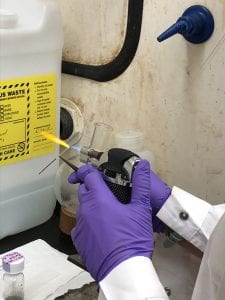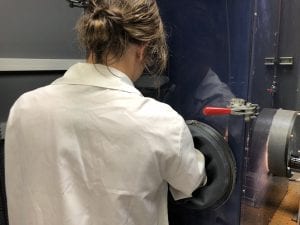During this fifth week of research, we’ve been able to move on past the purification of carbon nanotubes (CNTs). We were able to take the CNTs we put in solution with chlorosulfonic acid and make films.
To make films, you have to coat one side of a glass slide with the CNT solution. Then you place another slide on top of the first slide and move them around until the solution is dispersed.
Next you have to use a device built by a grad student in the lab to quickly shear the slides past each other. Both slides then drop into a jar of ether. The slides are removed and hopefully, you have a smooth film on each slide.
After the films dry on the slides, you gently use a spatula to push the film to the center of the slide until you have a fiber.
Once you have a fiber on the slide, you gently remove it and then twist it.
We were then able to measure the diameter of the fibers with a microscope and test the conductivity.
Unfortunately, our fibers aren’t the greatest quality. Moving forward, my mentor will be reviewing the purification process to find out if it’s damaging the CNTs. She’ll also be looking at the recipe and reactor conditions for synthesizing CNTs. And, I won’t be here to help! 🙁









